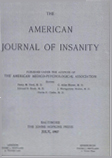ACUTE GENERAL PARESIS
Abstract
The acute onset of general paresis is a dramatic and often catastrophic event in the life of an individual. The initial symptoms have been described as being either a delirium, convulsive seizures, catatonic phenomena, or an acute confusional state. In general they show various grades of stupor and acute clouding of the consciousness. The acute onset carries with it a serious prognosis. The type which begins with a delirium usually runs a fulminating course. The three other types may also run a short and rapidly fatal course, but may progress into the chronic form of general paresis. The catatonic type of case, as has been pointed out, may be difficult to distinguish from schizophrenia but the serology and the marked organic intellectual disturbances differentiate the case of general paresis.
The pathology in these acute cases shows an extensive and active meningo-encephalitis. The vessels in the meninges, as well as in the cortex, have a pronounced mononuclear perivascular cuffing, and this reaction extends deeply into the cortical tissue. In general, the reaction is more intense than in the usual type of case11. In the usual chronic cases, the pathology is more marked in the frontal, parietal and temporal lobes in that order, and microspically, it is typical to find various grades of pathological alterations lying side by side with numerous cells that appear entirely normal. In the acute case one sees all cells of the cortex showing in various degrees indications of the disease process. These cells show Nissl's so-called grave alteration which probably results inevitably in the destruction of the cell. The cortical laminations show the characteristic distortion and a decrease in the number of neurones. Neuroglia stains reveal an increase in astrocytes, and vascular proliferation. Microglia stains show the typical rod cells. In some spirochaetes were demonstrated.
Merritt12 and his co-workers have shown that the capillaries in brains affected with general paresis are obstructed by swollen endothelial cells and that the hypertrophied endothelium contains phagocytosed spirochaetes and blood pigment. We suggest that the acute symptoms occurring in general paresis may be due to the marked vascular reaction as shown by the intense perivascular infiltration.
The rapidity of the course in many of these acute cases is such that often death may supervene before adequate treatment can be instituted. In an acute case, an emergency can be said to exist. Immediate treatment is imperative. It is true that in a large number of cases the acute symptoms will subside without treatment, but this cannot be predicted in the individual case, for it is difficult to decide which case will proceed to a fatal termination. This problem is in some respects similar to that of acute appendicitis. It requires emergency care and treatment.
Some13 have recommended immediate institution of fever therapy, malaria or other type. Others14 have recommended for prompt action the use of a soluble preparation of mercury, such as the bichloride, succinimide, or red iodide injected intramuscularly daily or every other day in doses varying from ⅛ to ½ grain.
Solomon15 and his co-workers have indicated that the preliminary use of tryparsamide injections greatly enhances the probabilities of therapeutic success in the treatment of general paresis by fever, and that the improvement of spinal fluid findings occurs more rapidly following fever if the patient has first been prepared by treatment with tryparsamide. This method appears to be readily applicable to an acute case. Whatever method is used, prompt institution of treatment is indicated in order to avoid a fatal termination.
Access content
To read the fulltext, please use one of the options below to sign in or purchase access.- Personal login
- Institutional Login
- Sign in via OpenAthens
- Register for access
-
Please login/register if you wish to pair your device and check access availability.
Not a subscriber?
PsychiatryOnline subscription options offer access to the DSM-5 library, books, journals, CME, and patient resources. This all-in-one virtual library provides psychiatrists and mental health professionals with key resources for diagnosis, treatment, research, and professional development.
Need more help? PsychiatryOnline Customer Service may be reached by emailing [email protected] or by calling 800-368-5777 (in the U.S.) or 703-907-7322 (outside the U.S.).



